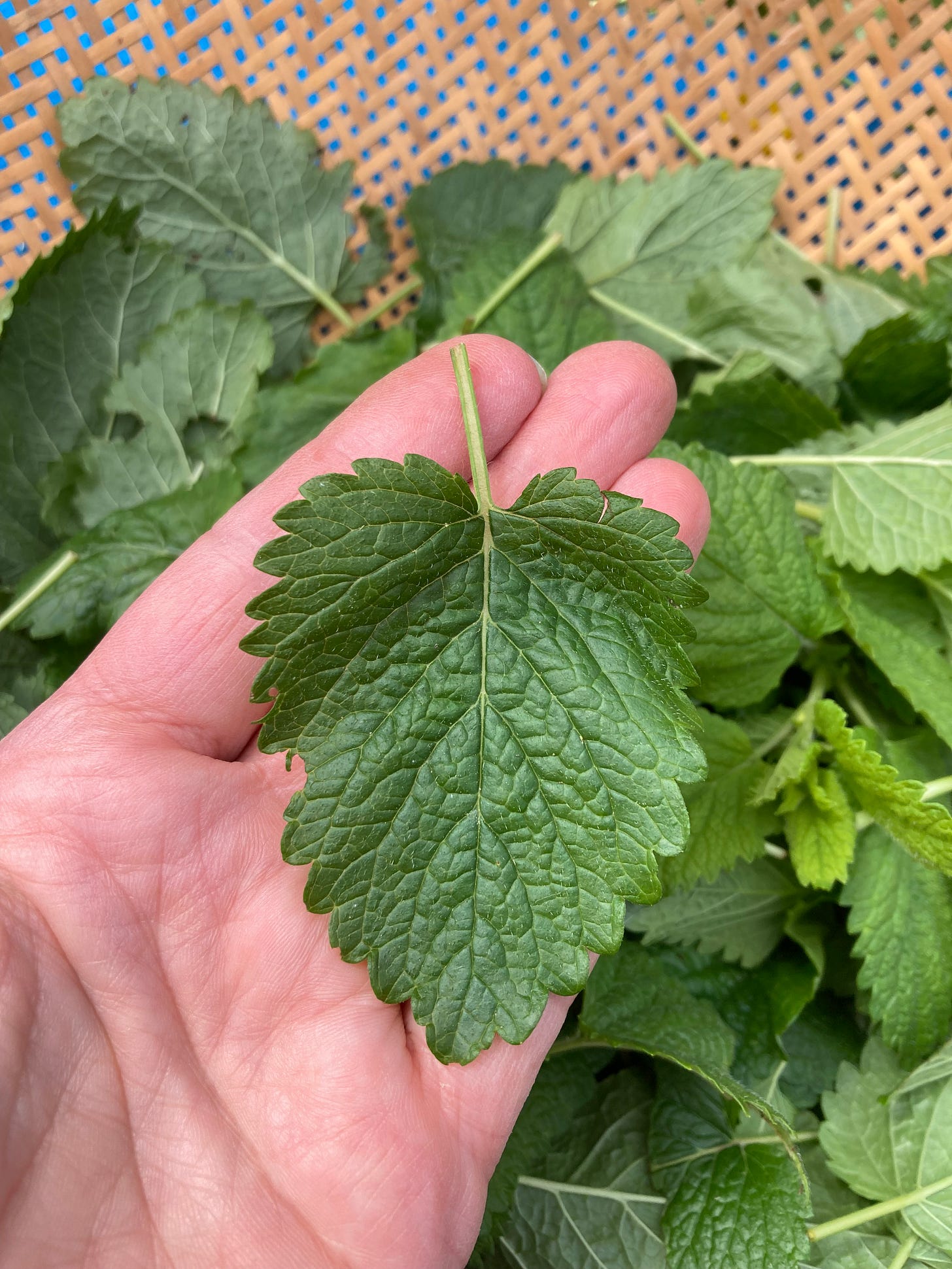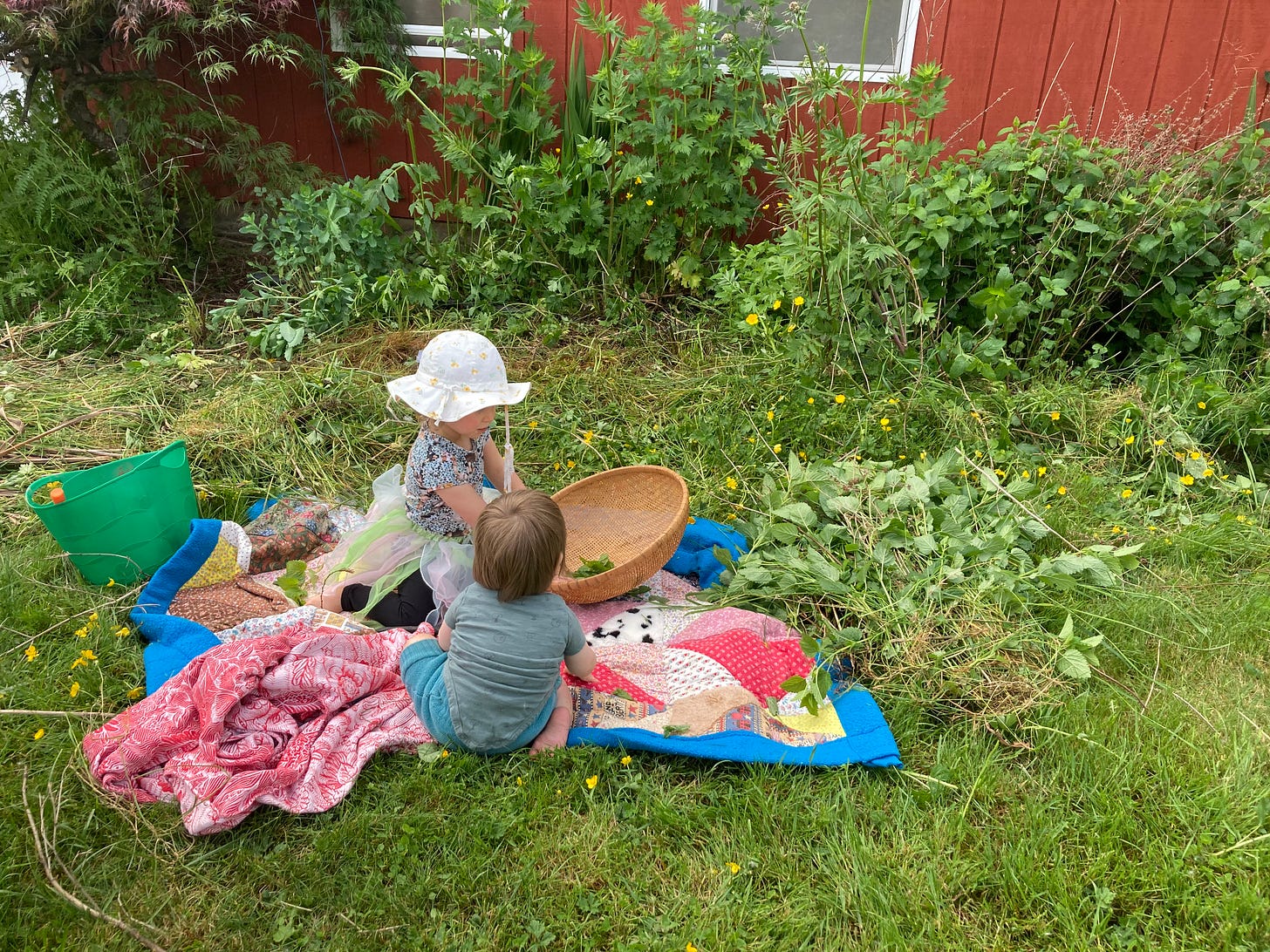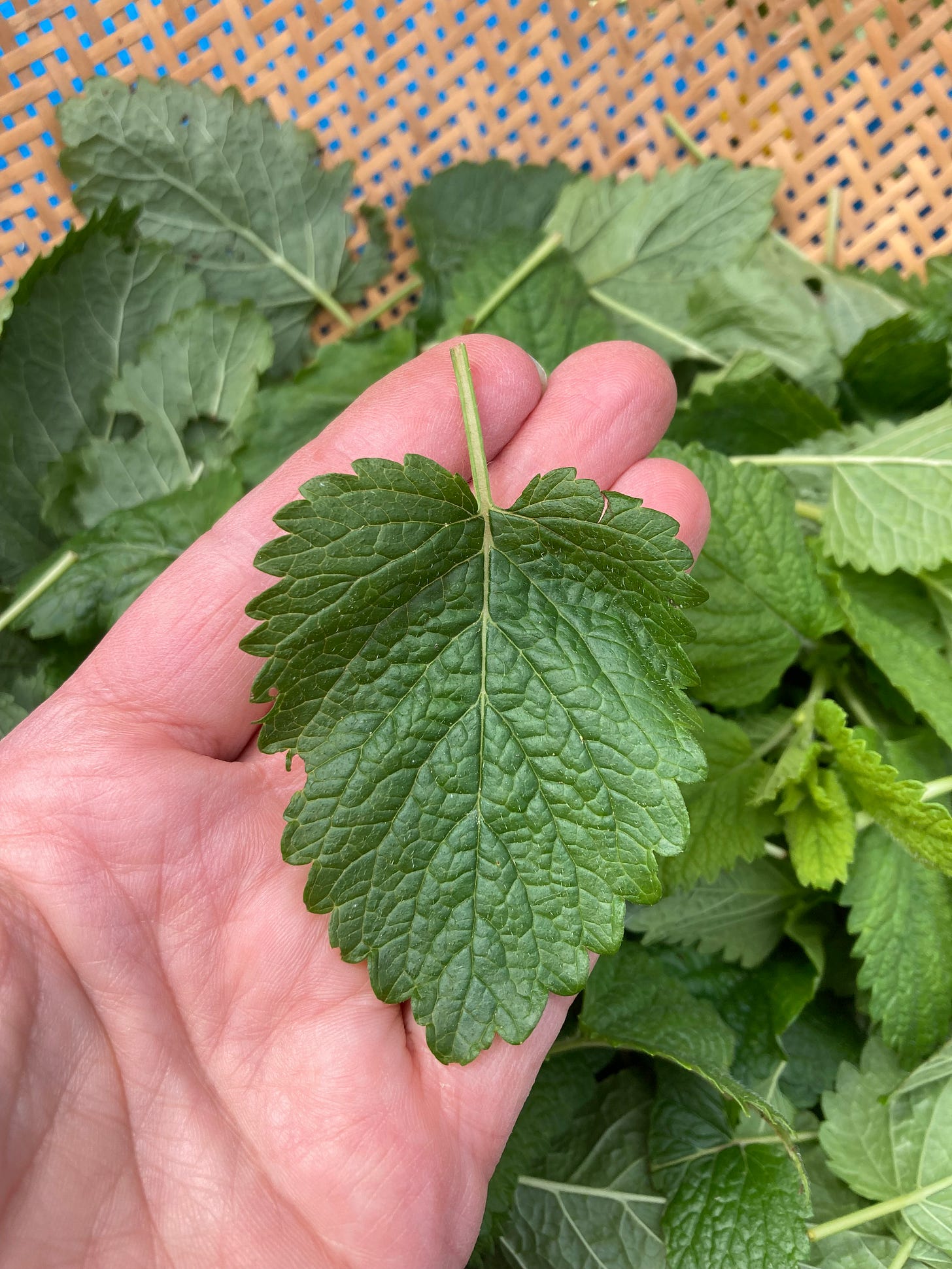Queen Witch Melissa
Children's stories, reading to daughters, witches, always witches, an herb for grief
Dear Ones-
Thank you for the feedback on this month’s interview with writer Laurie Parker. I’m so glad it landed well with many of you.
But please oh PLEASE just hit the tiny HEART BUTTON to say so. Liking a post is a small and easy way to show appreciation and increases odds that this wee newsletter can get circulated to a larger audience here on Substack.
In case you missed it -read it here!
I also forgot to mention that the upcoming TENDERS interview for June is a local Whatcom County, WA home birth midwife. As I re-read her interview it brought tears to my eyes and once again reminded me how more than ever we need compassionate, skilled caregivers who understand and respect physiologic birth, and can be in relationship with their clients as opposed to relationship over them. She was so generous with her answers and I think you’ll come away impressed by this interview as much as I was.
My tentative plan for the TENDERS interviews for those to be released on the 15th of each month/or mid-month more or less.
If you have an idea for someone you think would be a great fit for the TENDERS interviews please email me.
Yesterday it was sunny after days of rain.
The Lemonbalm or Melissa officinalis has taken over (like it does) one of my perennial garden beds. Lemonbalm like mint and other invasive things, if one must have them, ought to be planted in pots, but sometimes you forget and put them in the ground anyways. So while I ruthlessly pulled clumps of Lemonbalm out and showed my daughter how to strip the leaves from the stalks to dry for tea, in order to keep her engaged with the task and not bother her baby brother - I made up a story about a Queen Witch named Melissa.
What sets humans apart from many other creatures on planet Earth is that we like to make meaning about just about everything. Now I could go into all the medicinal qualities associated with said Melissa/Lemonbalm or I could craft a magical story about how she came to be based solely on the fact that I think her leaf when turned one way looks like a tear, and when flipped the other way looks like a heart. It’s easy to see then how people made creation stories and children-behave and lover-come-over stories all by simply paying attention to the shape and/or habits of a thing. (Fun fact there’s also a pretty woo woo principle in western Herbalism called "the doctrine of signatures” which loosely refers to the idea that the physical design of the plant itself clues you in what it’s medicinal properties are for. It’s kind of a fun hint hint- wink wink kind of a thing.. oh this dandelion root is strong and snaky and brown and fibrous- great for digestion or how walnuts look like little brains and they’re good for the brain)
I also know that had I prattled off certain words found to describe Melissa and her healing properties- tannins, terpenes, anti-spasmodic etc etc, I surely would have lost my soon-to-turn-four year old’s rapt attention, and more than likely yours as well. And more than just have lost her and yours attention, I would have lost the opportunity to create some lore, deepen the moment, tether ourselves back to this plant - invasive and maligned as the native plant dogmatic devotees like to make it, and in that way remind us that we humans aren’t the only ones taking up space.
Thus I made up a story about a Witch who was also a Queen and also a Mother of three- two boys and a girl, who just happened to be named Melissa. I won’t tell you the story here… for I fear I cannot re-tell it and many stories can only be told in person and don’t work well to be typed down or written out. But if you have read a fairy tale or two in your day you can probably guess what happens….. Queen Melissa’s children go missing, she sheds a tear, and out of that tear a plant grows to guide the way by instructing her to make a tea of it’s leaves…she does and in the night has such a vivid dream with clear instruction she shakes her husband awake…and yes it’s a happy ending kind of story with even a generous scene of the royalty taking food and provisions to the robbers who kidnapped the children for we all know that poverty and crime and inexplicably linked
Of course my daughter loved the story and soon enough we had a very full basket of Lemonbalm leaves that are drying on the collapsible mesh rack. (which I highly recommend as a space saving way to dry a reasonable amount of herbs for a family of 5-7 or small community house of people or a lively book group who like to drink regular amounts of herbal tea).
I have been thinking a lot about Witches for the past few months (let’s be honest I’ve been thinking about Witches now for years…) as my daughter Aubrey, like I was at her age and for years since has become entranced by classic fairy tales like Beauty and the Beast, Cinderella, Hansel and Gretel, The Wild Swans, Thumbelina, and more, as well as Disney movies- her favorites being Frozen 1 and Frozen 2, The Little Mermaid, Rapunzel and recently since she is "brave” enough, Brave. Over winter holiday while I was visiting my parents in South Carolina I described a game I used to play with my father; I’d direct him to lie down on the pine wood floor while I draped my blue baby blanket (knitted for me by my maternal grandmother Catherine) over my head and down along the backside of the couch while he called out “Rapunzel! Rapunzel! Let down you hair.” He has no memory of playing this game with me. And yet- that game and that story are woven into me. I have a vivid memory of reading the story or perhaps of having it read to me so much so I can conjure a feeling or a picture of that place and in particular the garden- the tall old stone tower where Rapunzel was locked up in, and the garden below filled with the rampion her mother so craved while pregnant with her. It would be decades before I’d understand how such a craving might make you do such foolhardy things as tell your husband to repeatedly trespass into the garden of a powerful sorcereress but anyone knows that a pregnant woman’s desires especially for certain bitter greens must not be denied. In the story version I remember hearing the greens were “rampion” a foreign word to me then and now; though in later years I’d re-imagine it was arugula that she craved- a leafy sharp bitter green I only came to know once I moved west, which I fell in love with- both the taste of the bitter rocket and the name Arugula. Arugula then imprinted on me and held a certain mythic spirit of "I have made it” from South Carolina and running from an abusive relationship and the stifling humidity to what I perceived as “freedom” to a hippie man and northern California. Thus, the rampion of my childhood and the arugula of my mid-twenties became one and the same.
As so happens when we re-vist things we loved from our youth, we see things in different light all together. I read these stories now that I adored- and in particular, illustrated versions by Susan Jeffers, Mercer Mayer’s collaborations with his first wife Marianna Mayer, Trina Schart Hyman’s work (who I only just learned was a lesbian and that makes me love her illustrations even more) and I see mostly whiteness, thinness, rigid gender norms and expectations, female frailty and lack of agency. All of these fairy tale books I am reading the witches are categorized simply as BAD. We never learn why witches want to eat children. Likewise in Disney’s famous version of The Little Mermaid, of which I’ve now watched half a dozen times in the past year, Ursula’s motivations for wanting to steal Ariel’s voice seem to be rooted in nothing more than plain old spite and shits and giggles, maybe some jealousy; the original telling of Hans Christian Anderson’s classic tale is much more harrowing with an ending that feels less tightly tied up in a pink satin bow. These stories I’ve been reading, more often than not it’s not even a witch but an evil step mother - whose husband is always portrayed as a bumbling cuckold who just lucked out to have the sweetest most generous most pure of heart most beautiful daughter on the planet, and yet really needs an older woman telling him what to do - you see this time and time again from The Wild Swans to Cinderella to Beauty and the Beast to Hansel and Gretel. There’s much more to be said about these themes, like those who analyze folk tales have done and will continue to do. While this remains worthy for phd candidates and others, I don’t have time and capacity for that right now. But I am interested now, in how do I read these stories now to my daughter and how do I reckon with their long standing influence in my own imagination and mythic sense of myself in the order of things? Re-visiting an image from Hyman’s Canterbury Tales made me think how deeply ingrained romantic monogamy culture has been and was for me, as I searched and pined and pined and searched and fucked and cried and cried and fucked and journaled and dreamed and pined for "the one.” Which frankly, is not a designation or a pressure I would ever put on my now husband Carsten (yet another benefit I supposed of waiting to marry til "later” in life. A visiting friend didn’t want their child to read our copy of The Wild Swans when Aubrey pulled it out, after they learned it’s not exactly a lighthearted story. Yet my daughter like myself, is already drawn to themes of power, loss, entrapment, heartbreak, transformation, and spell casting. But who can blame her?
The illustrated stories we are reading are copies I have procured via various second hand book outlets online. These versions by the authors and illustrators I mentioned prior, were published in the 1970s- 1990s. Susan Jeffer’s The Wild Swans I loved then and now, if only for her stunning illustrations, came out when I was seven years old. The Mayer’s version of Beauty and the Beast, when I was nine. When I was between three and four I sat still enough to listen to my father read me The Wizard of Oz by L. Frank Baum, first published in 1900, not exactly a picture book. To my daughter now, almost four years old sometimes I read these illustrated books as is. Many times I read them and skip words. Sometimes I change the words altogether to try to shine light on a character, invoke empathy for a situation not given in the original, or add my judgemental commentary altogether- like telling Thumbelina to get lost from that awful Mr. Mole already!!
Last week my husband took our daughter up to the library as they like to do together. He helped her find all the princess books and sparkly books they could because this is what she wants. Later that night I read her one of the new books. It’s a re-telling of Cinderella and the origin story of how the Cinderella Pumpkin came to be. It’s a great story and spoiler- Cinderella wants to decide her own fate and turns out she falls in love with a (lady) farmer. Go read it!
After I told the story about Queen Witch Melissa who in this case as you’ve guessed, Witch means healer and herbalist, my daughter wanted more stories. Which didn’t surprise me and yet it was time for baby’s nap time and mom’s mental rest- i.e. boop on my phone in the rocking chair and see what's happening in my online babywearing community. It’s fascinating to me to consider how we learn the spectrum of right and wrong. Around the world cultures have employed storytelling for a variety of purposes- such as my impetus to get this chore done and keep the peace between sister and a cranky baby. I read a little more about the Brothers Grimm while writing this piece, which was a book we were assigned to read when I was a student in the now shuttered Orphan Wisdom School. I was reminded that that the majority of the stories collected so methodically by Wilhelm and Jacob Grimm were not meant to be told to children; they were adult stories and thus the rampant sex and violence that eventually became associated with earlier versions of the stories. Those that were meant for children like Little Red Riding Hood, were supposed to instill fear as a cautionary tale and way to keep children in line.
What wonders when we don’t have stories to tell about the way things are? It seems most of the stories running the culture right now are far from rooted in any community or place based setting? As much as we may like to critique the fairy tales of Hans Christian Anderson and the Grimm Brothers grim tales- they were all birthed for certain times and places and employed magical elements that seem to elevate or at least temper the hard truths sown into the story’s lessons. My parents didn’t let us watch TV growing up except for occasional VHS tapes procured from the local library when we were sick or on special movie nights- my favorites, and probably unsurprisingly if you've read this far, were Shelley Duvall’s Fairy Tale Theatre, Watership Down, and The Princess Bride. While Fairy Tale Theatre was pretty tame, both Watership Down and The Princess Bride have quite a few elements of violence and grief. I think many children and young people come to Earth already knowing Life is rife with grief and violence- and I don’t mean coercive abusive violence- I mean a ocean wave swallowing a boat during a storm, an Eagle hunting a rabbit, a man lost to the woods on a hunting trip…. stories aren’t just for bedtime fun but they are necessary for survival. Perhaps this is a bit of a philosophical leap- but it seems that without local stories say that describe a child getting lost in the woods to which eventually you might learn how to get your way out of there giving offerings to the Trees that live there, or learning to follow Deer Tracks, we are left only with stories about feelings, love, longing… these often fleeting things that are not often tethered to the actual elements we need to get by. When was the last time you heard a love song to an Apple tree on Virgin radio- sure apple bottom jeans- most modern storytelling doesn’t tell you much about what it actually takes to live in the place where you live.
I have wondered here and there over the past year on whether or not I have introduced these older illustrated fairy tales and Disney to my daughter too soon. While we set age appropriate limits for screen time, in a time of childcare crisis and not much extended family help, like many modern families screen time is a sanity- saving invention. I don’t put limits on books and her access to books except the two book at bedtime rule. I see how entranced and curious she is about these fairy tales and these princess movies. Sometimes she reads or watches them alone while I am across the room cooking dinner or writing or nursing the baby etc; often we read and/or watch them together. And I do love to see how the princesses have changed over the years- Elsa and Ana’s story shows a much more healthy sister relationship than Beauty and her sisters in Mayer’s book; Merida in Brave is a wholly different red head than Ariel (which could be, of course due to the fact that Merida’s mother is named Eleanor, and we all know that women named Eleanor are quite something while Ariel was raised by that hot head King Triton).
Last night at bedtime as my daughter begged me to stay longer, I asked her to tell me a story instead. I told her it has to start it my favorite way of all.
And so she began with "Once upon a time…”
and proceeded to tell me the sweetest story of birds and turtles and robins bursting out of their blue eggs and "bees getting nectar” and a great blue heron dipping its beak into the pond.
Other things tangentially related elsewhere on the web!
Botany lesson related to Rapunzel
More on Melissa
Jack Sipes knows The Grimm Brothers.
Of course the version of this tale I loved is now $100 for a used copy
Peggy Orenstein’s 2006 OP-ed asking is Cinderella really that bad for my daughter?
All the illustrations from Susan Jeffer’s The Wild Swans
Queer authors of magical children’s books were formative on boomers and gen x!! Margaret Wise Brown?!?!?!?
For a fun and wildly inventive subversive take on fairy tales check out Kelly Link’s book of short stories, White Cat, Black Dog.











